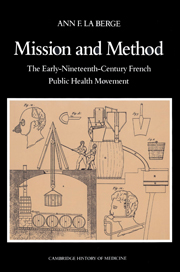Book contents
- Frontmatter
- Contents
- List of tables and illustrations
- Preface
- Acknowledgments
- Introduction
- I Community, method, context
- II Carrying out the mission: Institutionalization, investigation, moralization, and practical reform
- Chapter 4 Institutionalization: The health councils
- Chapter 5 Investigation and moralization: Occupational hygiene and industrialization
- Chapter 6 Investigation and practical reform: Public health in Paris
- Chapter 7 Public health in Paris: Investigation, salubrity, and social welfare
- III Public health before Pasteur
- Epilogue
- Appendixes
- Bibliographical Note
- Index
Chapter 4 - Institutionalization: The health councils
Published online by Cambridge University Press: 17 September 2009
- Frontmatter
- Contents
- List of tables and illustrations
- Preface
- Acknowledgments
- Introduction
- I Community, method, context
- II Carrying out the mission: Institutionalization, investigation, moralization, and practical reform
- Chapter 4 Institutionalization: The health councils
- Chapter 5 Investigation and moralization: Occupational hygiene and industrialization
- Chapter 6 Investigation and practical reform: Public health in Paris
- Chapter 7 Public health in Paris: Investigation, salubrity, and social welfare
- III Public health before Pasteur
- Epilogue
- Appendixes
- Bibliographical Note
- Index
Summary
Although some public health concerns such as epidemics, vaccination, and child labor attracted the attention of the national government, public health administration was principally a municipal and departmental affair. The creation of advisory health councils (conseils de salubrité) at the municipal and departmental levels to assist prefects and mayors in regulating public health was characteristic of the period. The idea of a permanent advisory commission on public health dated from the Revolution, and the first French health council, the Paris health council, which became the model for all French councils, was founded in 1802 by the prefect of police of Paris, Dubois. By the 1830s, when the French public health movement was at the height of its activity, the health council idea had spread to other cities and departments, and Nantes, Lyon, Marseilles, Lille, Strasbourg, Bordeaux, Rouen, Troyes, and Toulouse had their own advisory councils.
THE PARISIAN PUBLIC HEALTH ADMINISTRATION: THE PREFECTURE OF POLICE AND THE PARIS HEALTH COUNCIL
The Parisian public health administration consisted of the prefecture of police, the institution in charge of public health for the city, and the Paris health council, the advisory body to the prefect of police and the one institution devoted solely to the preservation of the public health in Paris. Paris and the department of the Seine were governed by two magistrates, the prefect of the Seine and the prefect of police, each appointed by the Minister of the Interior.
- Type
- Chapter
- Information
- Mission and MethodThe Early Nineteenth-Century French Public Health Movement, pp. 113 - 147Publisher: Cambridge University PressPrint publication year: 1992



